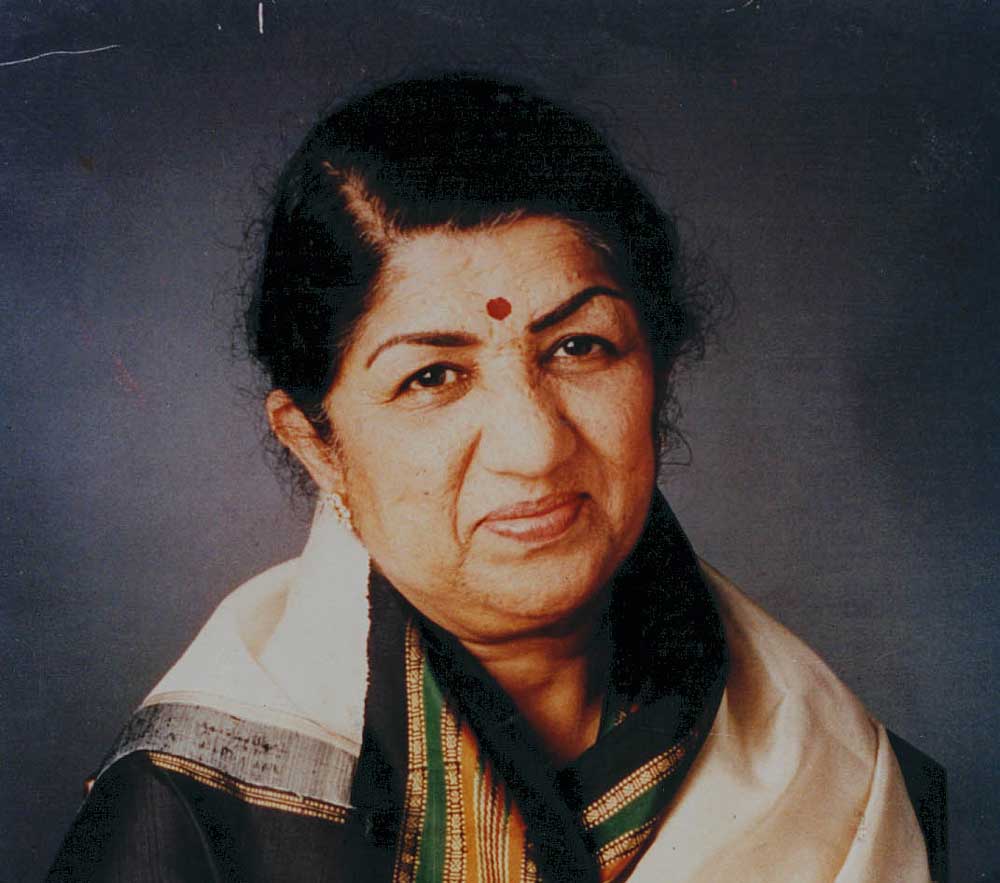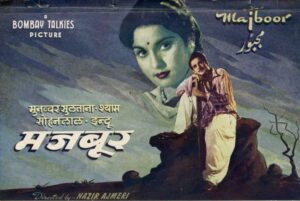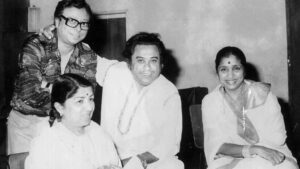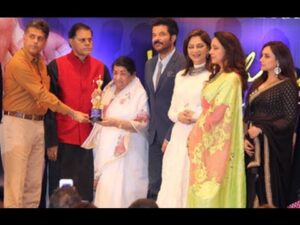
Lata Mangeshkar Biography
Actor, Singer, Compose, Producer (1963–2016)
From Wikipedia and The Editors of Encyclopaedia Britannica

Lata Mangeshkar, (born September 28, 1929, Indore, British India), legendary Indian playback singer noted for her distinctive voice and a vocal range that extended over more than three octaves. Her career spanned nearly six decades, and she recorded songs for the soundtracks of more than 2,000 Indian films.
Biography
Early life
 Lata Mangeshkar was born in 1929, the eldest daughter of Pandit Deenanath Mangeshkar, a Marathi and Konkani musician and his wife Shevanti in Indore (in present-day Madhya Pradesh and then the capital of the princely state of Indore which was part of the Central India Agency in British India). Her father, Pandit Deenanath Mangeshkar, was a classical singer and theatre actor. Her mother, Shevanti (later renamed Shudhamati), a Gujarati woman from Thalner, Bombay Presidency (now in northwest Maharashtra), was Deenanath’s second wife; his first wife Narmada, who had died, was Shevanti’s older sister.
Lata Mangeshkar was born in 1929, the eldest daughter of Pandit Deenanath Mangeshkar, a Marathi and Konkani musician and his wife Shevanti in Indore (in present-day Madhya Pradesh and then the capital of the princely state of Indore which was part of the Central India Agency in British India). Her father, Pandit Deenanath Mangeshkar, was a classical singer and theatre actor. Her mother, Shevanti (later renamed Shudhamati), a Gujarati woman from Thalner, Bombay Presidency (now in northwest Maharashtra), was Deenanath’s second wife; his first wife Narmada, who had died, was Shevanti’s older sister.
Lata’s paternal grandfather, Ganesh Bhatt Navathe Hardikar (Abhisheki), was a Karhade Brahmin priest who performed the abhishekam of the Shiva lingam at the Mangueshi Temple in Goa, and her paternal grandmother, Yesubai Rane, belonged to the Gomantak Maratha Samaj community of Goa.
Lata’s maternal grandfather was Gujarati businessman Seth Haridas Ramdas Lad, a prosperous businessman and landlord of Thalner; and Mangeshkar learnt Gujarati folk songs such as garbas of Pavagadh from her maternal grandmother.
The family’s last name used to be Hardikar; Deenanath changed it to Mangeshkar in order to identify his family with his native town, Mangeshi in Goa. Lata was named “Hema” at her birth. Her parents later renamed her Lata after a female character, Latika, in one of her father’s plays, BhaawBandhan.
 Lata is the eldest child of the family. Meena, Asha, Usha, and Hridaynath, in birth order, are her siblings, all accomplished singers and musicians.
Lata is the eldest child of the family. Meena, Asha, Usha, and Hridaynath, in birth order, are her siblings, all accomplished singers and musicians.
Lata received her first music lesson from her father. At the age of five, she started to work as an actress in her father’s musical plays (Sangeet Natak in Marathi). On the first day in school, that she left school because they would not allow her to bring Asha with her, as she would often bring her younger sister with her. She has four siblings—Meena Khadikar, Asha Bhosle, Usha Mangeshkar, and Hridaynath Mangeshkar—of whom she is the eldest.
Singing Career
In 1942, when Lata was 13, her father died of heart disease. Master Vinayak (Vinayak Damodar Karnataki), the owner of Navyug Chitrapat movie company and a close friend of the Mangeshkar family, took care of them. He helped Lata get started in a career as a singer and actress.
Lata sang the song “Naachu Yaa Gade, Khelu Saari Mani Haus Bhaari”, which was composed by Sadashivrao Nevrekar for Vasant Joglekar’s Marathi movie Kiti Hasaal (1942), but the song was dropped from the final cut. Vinayak gave her a small role in Navyug Chitrapat’s Marathi movie Pahili Mangalaa-gaur (1942), in which she sang “Natali Chaitraachi Navalaai” which was composed by Dada Chandekar. Her first Hindi song was “Mata Ek Sapoot Ki Duniya Badal De Tu” for the Marathi film Gajaabhaau (1943).
Lata moved to Mumbai in 1945 when Master Vinayak’s company moved its headquarters there. She started taking lessons in Hindustani classical music from Ustad Aman Ali Khan of Bhindibazaar Gharana. She sang “Paa Lagoon Kar Jori” for Vasant Joglekar’s Hindi-language movie Aap Ki Seva Mein (1946), which was composed by Datta Davjekar. The dance in the film was performed by Rohini Bhate who later became a famous classical dancer. Lata and her sister Asha played minor roles in Vinayak’s first Hindi-language movie, Badi Maa (1945). In that movie, Lata also sang a bhajan, “Maata Tere Charnon Mein.” She was introduced to music director Vasant Desai during the recording of Vinayak’s second Hindi-language movie, Subhadra (1946).
 After Vinayak’s death in 1948, music director Ghulam Haider mentored her as a singer. He introduced Lata to producer Sashadhar Mukherjee, who was working then on the movie Shaheed (1948), but Mukherjee dismissed Lata’s voice as “too thin”. An annoyed Haider responded that in coming years producers and directors would “fall at Lata’s feet” and “beg her” to sing in their movies. Haider gave Lata her first major break with the song “Dil Mera Toda, Mujhe Kahin Ka Na Chhora”—lyrics by Nazim Panipati—in the movie Majboor (1948), which became her first big breakthrough film hit. In an interview on her 84th birthday, in September 2013, Lata herself declared, “Ghulam Haider is truly my Godfather. He was the first music director who showed complete faith in my talent.”
After Vinayak’s death in 1948, music director Ghulam Haider mentored her as a singer. He introduced Lata to producer Sashadhar Mukherjee, who was working then on the movie Shaheed (1948), but Mukherjee dismissed Lata’s voice as “too thin”. An annoyed Haider responded that in coming years producers and directors would “fall at Lata’s feet” and “beg her” to sing in their movies. Haider gave Lata her first major break with the song “Dil Mera Toda, Mujhe Kahin Ka Na Chhora”—lyrics by Nazim Panipati—in the movie Majboor (1948), which became her first big breakthrough film hit. In an interview on her 84th birthday, in September 2013, Lata herself declared, “Ghulam Haider is truly my Godfather. He was the first music director who showed complete faith in my talent.”
Initially, Lata is said to have imitated the acclaimed singer Noor Jehan, but later she developed her own style of singing. Lyrics of songs in Hindi movies are primarily composed by Urdu poets and contain a higher proportion of Urdu words, including the dialogue. Actor Dilip Kumar once made a mildly disapproving remark about Lata’s Maharashtrian accent while singing Hindi/Urdu songs; so for a period of time, Lata took lessons in Urdu from an Urdu teacher named Shafi. In subsequent interviews, Lata has said that Noor Jehan had heard her as a child and had told her to practice a lot. The two stayed in touch with each other for many years to come.
One of her first major hits was “Aayega Aanewaala,” a song in the movie Mahal (1949), composed by music director Khemchand Prakash and lip-synced on screen by actress Madhubala.
 After Mangeshkar recorded the hit “Uthaye ja unke sitam” in Andaz (1949), her destiny was sealed. From that point on she voiced the musical parts for every major leading lady, representing every generation of Hindi cinema from Nargis and Waheeda Rehman to Madhuri Dixit and Preity Zinta. Music directors such as Naushad Ali, Madan Mohan, and S.D. Burman composed tunes specifically to exploit the potential of her wide-ranging soprano. Mangeshkar’s singing contributed a great deal to the commercial success of such films as Mahal (1949), Barsaat (1949), Satyam shivam sundaram (1978), and Maine pyar kiya (1989). Notable among her concert performances was her wartime rendition of the poet Pradeep’s patriotic song “Ae mere watan ke logo,” which moved Indian Prime Minister Jawaharlal Nehru to tears.
After Mangeshkar recorded the hit “Uthaye ja unke sitam” in Andaz (1949), her destiny was sealed. From that point on she voiced the musical parts for every major leading lady, representing every generation of Hindi cinema from Nargis and Waheeda Rehman to Madhuri Dixit and Preity Zinta. Music directors such as Naushad Ali, Madan Mohan, and S.D. Burman composed tunes specifically to exploit the potential of her wide-ranging soprano. Mangeshkar’s singing contributed a great deal to the commercial success of such films as Mahal (1949), Barsaat (1949), Satyam shivam sundaram (1978), and Maine pyar kiya (1989). Notable among her concert performances was her wartime rendition of the poet Pradeep’s patriotic song “Ae mere watan ke logo,” which moved Indian Prime Minister Jawaharlal Nehru to tears.
In 1991 Mangeshkar was credited with having made 30,000 solo, duet, and chorus-backed song recordings in 14 Indian languages between 1948 and 1987. She won four Filmfare awards (Filmfare is a noted Indian film magazine) for her song “Aaja re pardesi” from the film Madhumati (1958), for “Kahin deep jale kahin dil” from Bees saal baad (1962), for “Tumhi mere mandir” from the film Khandaan (1965), and for “Aap mujhe acchhe lagne lage” from the film Jeene ki raah (1969). She was awarded the Padma Vibhushan, one of India’s highest civilian honours, in 1999, and two years later she became only the second film celebrity (the first was Satyajit Ray in 1992) to receive the Bharat Ratna (2001), India’s highest civilian award for performance of the highest order in any field. Mangeshkar’s sister Asha Bhosle was also a noted playback singer.
Overall Collaboration
From the 1940s to the 1970s, Mangeshkar sang duets with Asha Bhosle, Suraiya, Shamshad Begum , Usha Mangeshkar, Mohammed Rafi, Kishore Kumar, Mukesh, Manna Dey, Hemant Kumar, and Mahendra Kapoor. In 1964, she sang “Chanda Se Hoga” with P.B. Sreenivas from Main Bhi Ladki Hoon.
 Mukesh died in 1976. The 1980s saw the deaths of Mohammed Rafi and Kishore Kumar. Mangeshkar’s last duets with Mohammed Rafi were during the 1980s; she continued to sing with Shabbir Kumar, Shailendra Singh, Nitin Mukesh (Mukesh’s son), Manhar Udhas, Amit Kumar (Kishore Kumar’s son), Mohammed Aziz, Vinod Rathod, and S.P. Balasubrahmanyam.
Mukesh died in 1976. The 1980s saw the deaths of Mohammed Rafi and Kishore Kumar. Mangeshkar’s last duets with Mohammed Rafi were during the 1980s; she continued to sing with Shabbir Kumar, Shailendra Singh, Nitin Mukesh (Mukesh’s son), Manhar Udhas, Amit Kumar (Kishore Kumar’s son), Mohammed Aziz, Vinod Rathod, and S.P. Balasubrahmanyam.
In the 1990s, Mangeshkar began singing duets with Pankaj Udhas, Mohammed Aziz, Abhijeet Bhattacharya, Udit Narayan, Kumar Sanu, and Suresh Wadkar. Her most notable work of the 90s was Dilwale Dulhania Le Jayenge with songs such as “Mere Khwabon Mein Jo Aaye”, “Ho Gaya Hai Tujhko To Pyaar Sajna”, “Tujhe Dekha To Yeh Jana Sanam”, and “Mehndi Laga Ke Rakhna”.
In the 2000s, Mangeshkar’s duets were mainly with Udit Narayan and Sonu Nigam. 2005-06 were the years of her last well-known songs: “Kaise Piya Se” from Bewafa and “Shayad Yehi To Pyaar Hai” from Lucky: No Time for Love, with Adnan Sami and ” Lukka Chhupi” in Rang De Basanti (2006 film) with A.R.Rahman. She sang “Ek Tu Hi Bharosa” from Pukar. Other notable songs of this decade were from Veer-Zaara, sung with Udit Narayan, Sonu Nigam, Jagjit Singh, Roop Kumar Rathod, and Gurdas Mann. One of her latest songs was “Jeena Hai Kya” from Dunno Y2 (2014).
Non-singing Career
Music direction
Lata Mangeshkar composed music for the first time in 1955 for the Marathi movie Ram Ram Pavhane. Later in the 1960s, she composed music for following Marathi movies under the pseudonym of Anand Ghan.
1960 – Ram Ram Pavhana
1963 – Maratha Tituka Melvava
1963 – Mohityanchi Manjula
1965 – Sadhi Manase
1969 – Tambadi Mati
She won Maharashtra State Government’s Best Music Director Award for the film Sadhi Manase. The song “Airanichya Deva Tula” from the same film received best song award.
Production
Lata Mangeshkar has produced four films:
1953 – Vaadal (Marathi)
1953 – Jhaanjhar (Hindi), co-produced with C. Ramchandra
1955 – Kanchan Ganga (Hindi)
1990 – Lekin… (Hindi)
Awards and Recognitions
Lata Mangeshkar has won several awards and honours, including Bharat Ratna (India’s Highest Civilian Award), Padma Bhushan (1969), Padma Vibhushan (1999), Zee Cine Award for Lifetime Achivements (1999), Dadasaheb Phalke Award (1989), Maharashtra Bhushan Award (1997), NTR National Award (1999), Bharat Ratna (2001), Legion of Honour (2007), ANR National Award (2009), three National Film Awards and 15 Bengal Film Journalists’ Association Awards. She has also won four Filmfare Best Female Playback Awards. In 1969, she made the unusual gesture of giving up the Filmfare Best Female Playback Award, in order to promote fresh talent. She was later awarded Filmfare Lifetime Achievement Award in 1993 and Filmfare Special Awards in 1994 and 2004.
 In 1984, the State Government of Madhya Pradesh instituted the Lata Mangeshkar Award in honour of Lata Mangeshkar. The State Government of Maharashtra also instituted a Lata Mangeshkar Award in 1992.
In 1984, the State Government of Madhya Pradesh instituted the Lata Mangeshkar Award in honour of Lata Mangeshkar. The State Government of Maharashtra also instituted a Lata Mangeshkar Award in 1992.
In 2009, Mangeshkar was awarded the title of Officer of the French Legion of Honour, France’s highest order.
In 2012, Mangeshkar was ranked number 10 in Outlook India’s poll of the Greatest Indian.
Ustad Bade Ghulam Ali Khan said kambakht, kabhi besuri na hoti (“[she] is never off-key”). Dilip Kumar once said, “Lata Mangeshkar ki awaaz kudrat ki takhleek ka ek karishma hain,” meaning “Lata Mangeshkar’s voice is a miracle from God.”
Mangeshkar is also a recipient of honorary doctorates from the Sangeet Natak Akademi in 1989, Indira Kala Sangeet Vishwavidyalaya, Khairagarh, and Shivaji University in Kolhapur.
Related Videos
Features
Copyright © 2018 SEAN-O-VISTA

Powered with 


